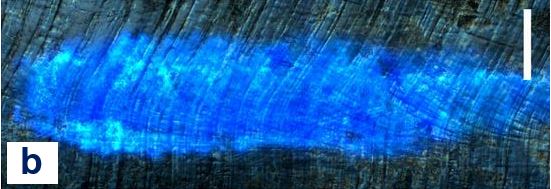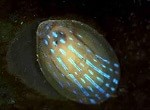A tiny mollusk, the blue-rayed limpet, has natural optical structures which could be used for transparent displays on screens, including car windscreens (US English: windshields), without the need for an internal light source, say scientists at MIT and Harvard University.
The blue-rayed limpet (Patella pellucida), 15 mm long (0.59 of an inch) when fully grown, can be found in kelp beds along the coasts of the United Kingdom, Portugal, the Canary Islands, Norway and Iceland.
It is a creature that would escape notice except for a very noticeable feature: bright blue dotted lines that run along their translucent shells. The limpet’s shell can flash brilliantly even in muddy waters.

Optical image of a limpet shell showing the reflection of light from the shell exterior. Scale bar, 2 mm. See close-up in image ‘B’ below. (Image: Nature Communications)
Scientists have now identified two optical structures within the mollusk’s shell that give its blue-striped appearance. The structures are configured in such a way that they reflect just blue light and absorb all the other wavelengths of incoming light.
Mathias Kolle, an assistant professor of mechanical engineering at MIT, and colleagues speculate that such patterning may have evolved as a survival feature – the blue lines look like the colour displays found on poisonous soft-bodied snails.
The scientists, whose findings have been published in the academic journal Nature Communicaitons (citation below), say they represent the first evidence of a living being using mineralized structure components to produce optical displays.
Butterflies, birds and beetles display brilliant blues, as well as other colours with the use of organic structures, such as scales, plates and feathers. Limpets, on the other hand, produce their blue stripes through the interplay of inorganic, mineral structures, configured in such a way as to reflect just blue light.
The scientists believe such natural optical structures could be used to engineer colour-selective, controllable, transparent displays that do not require an internal light source. This could be incorporated into glasses and windows.

Reflection optical micrograph of a single stripe. Scale bar, 100 μm. (Image: Nature Communications)
“Let’s imagine a window surface in a car where you obviously want to see the outside world as you’re driving, but where you also can overlay the real world with an augmented reality that could involve projecting a map and other useful information on the world that exists on the other side of the windshield.”
“We believe that the limpet’s approach to displaying color patterns in a translucent shell could serve as a starting point for developing such displays.”
Optical structures and photonic materials
Prof. Kolle became interested in the limpet’s optical features when Stefan Kolle (his brother), a Harvard marine biologist, brought him a few of the creatures in a small container.
Stefan Kolle was fascinated by the limpet’s brilliant patterning, and asked his brother, as well as some other scientists, to try and look into the mollusk shell’s optical properties more deeply.
To do this, the research team – which also included Joanna Aizenberg and James Weaver at Harvard, and Ling Li and Christine Ortiz at MIT – carried out a comprehensive structural and optical analysis of the limpet shells.
They noticed that when the limpets were young (juveniles), blue stripes resembling dashed lines would appear. As the creature matured the lines would become more continuous, and their shades varied from specimen to specimen, ranging from turquoise to deep blue.
With the use of scanning electron microscopy they scanned the surface of a limpet’s shell and were surprised to find there was no structural difference in areas with and without stripes. They wondered whether the stripes might have arisen from features embedded deeper within the shell.
So they studied deeper within the shell
In order to see what lay deep within the translucent shell, the scientists used a combination of high-resolution 2- and 3-D structural analysis to reveal the 3-D nanoarchitecture of the photonic structures.
They found that in the regions with the blue stripes, the top and bottom layers of the shell were relatively uniform, with thin organic layers and dense stacks of calcium carbonate platelets, as one would find in other mollusks.
However, about 30 microns (0.03 mm) beneath the surface of the shell, the scientists noted a stark difference. In these regions the regular plates of calcium carbonate transformed into two distinct structural features: 1. a multilayered structure with regular spacing between calcium carbonate layers in a zigzag pattern. 2. and further below, a layer of randomly dispersed, spherical particles.
They measured the dimensions of the zigzagging plates and found they were spaced further apart from each other than the more uniform plates running through the shell’s unstriped sections.
They then set out to determine what the potential optical roles of the spherical particles and multilayer zigzagging structure might be.
Prof. Kolle and team used spectroscopy, optical microscopy, and diffracting microscopy to quantify the light-reflection properties of the blue stripe. Then, they measured the zigzagging structures and their angles with respect to the surface of the shell, and found that this structure had been optimized to reflect blue and green light.
The scientists believe that the randomly dispersed spherical particles beneath the zigzagging structures are there to absorb the transmitted light that would otherwise de-saturate the reflected blue light.
They deduced that the zigzag pattern serves as a filter, reflecting just blue light. The rest of the light is absorbed by the underlying spherical particles, thus making the shells stripes appear even more brilliantly blue.
What are the blue stripes for?
Limpets live either hidden at the base of kelp plants, or further up in the fronds, where they can be seen by predators.
Those at the base of the plants have almost no stripes and a thicker shell, while their blue-striped cousins live higher on the plant.
The researchers doubt the blue stripes serve as a communication tool, because limpets cannot see very well.
Prof. Kolle and team believe the blue stripes could be a defensive mechanism. If you exist on the top of plants exposed to predators you have to options: appear unappetizing or invisible.
The blue stripes look very similar to the patterning found in poisonous marine snails, which also inhabit similar kelp beds.
Prof. Kolle says the study findings could be exploited to engineer advanced transparent optical displays. “The limpet has evolved a microstructure in its shell to satisfy an optical purpose without overly compromising the shell’s mechanical integrity. Materials scientists and engineers could take inspiration from this natural balancing act,” he explains.
Prof. Kolle added:
“It’s all about multifunctional materials in nature: Every organism – no matter if it has a shell, or skin, or feathers – interacts in various ways with the environment, and the materials with which it interfaces to the outside world frequently have to fulfill multiple functions simultaneously.”
“[Engineers] are more and more focusing on not only optimizing just one single property in a material or device, like a brighter screen or higher pixel density, but rather on satisfying several … design and performance criteria simultaneously. We can gain inspiration and insight from nature.”
According to Peter Vukusic, an associate professor of physics at the University of Exeter in England, the researchers “have done an exquisite job” discovering the optical mechanism behind the limpet’s unique appearance.
Prof. Vukusic, who was not involved in the study, said:
“By using multiple and complementary analysis techniques they have elucidated, in glorious detail, the many structural and physiological factors that have given rise to the optical signature of this highly evolved system. The animal’s complex morphology is highly interesting for photonics scientists and technologists interested in manipulating light and creating specialized appearances.”
The study was partly funded by the Alexander von Humboldt Foundation, the National Science Foundation and the Air Force Office of Scientific Research.
Citation: “A highly conspicuous mineralized composite photonic architecture in the translucent shell of the blue-rayed limpet,” Ling Li, Stefan Kolle, James C. Weaver, Christine Ortiz, Joanna Aizenberg & Mathias Kolle. Nature Communications. February 26, 2015. DOI: 10.1038/ncomms7322.

